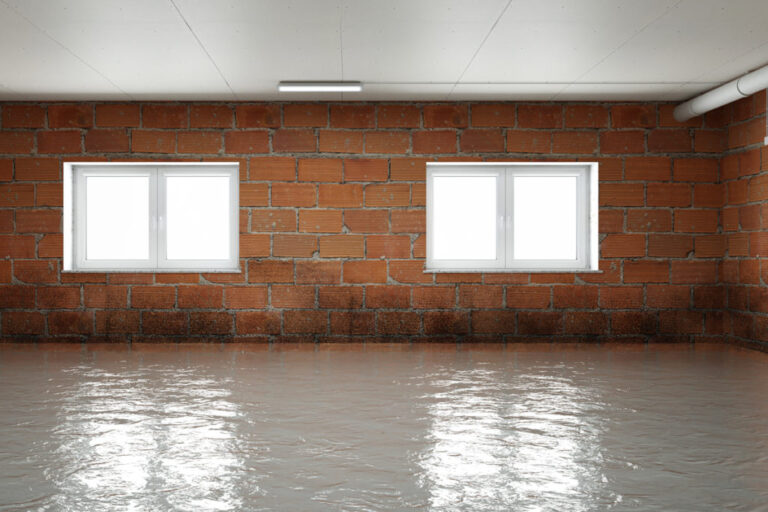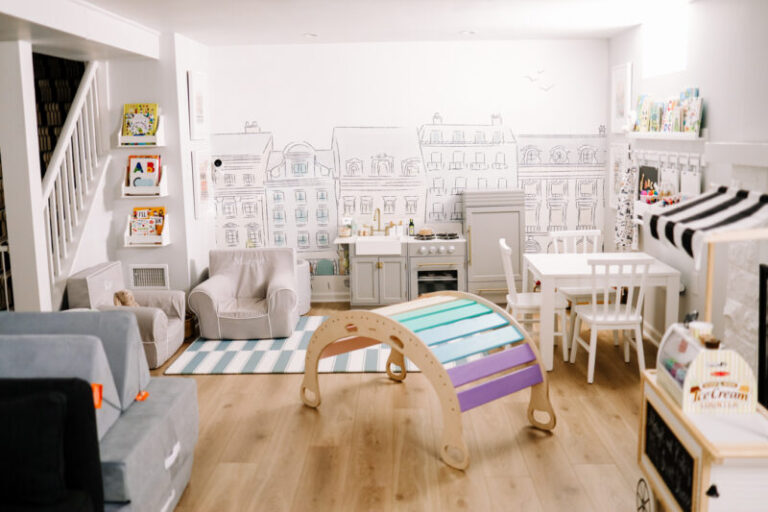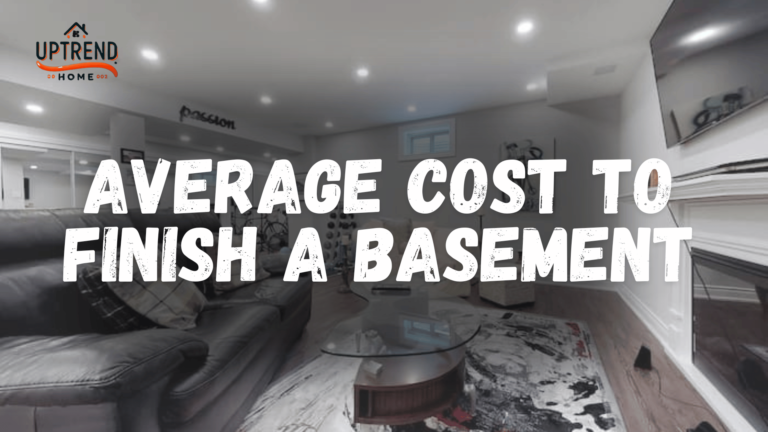What Color to Paint Basement Ceiling: The Ultimate Guide
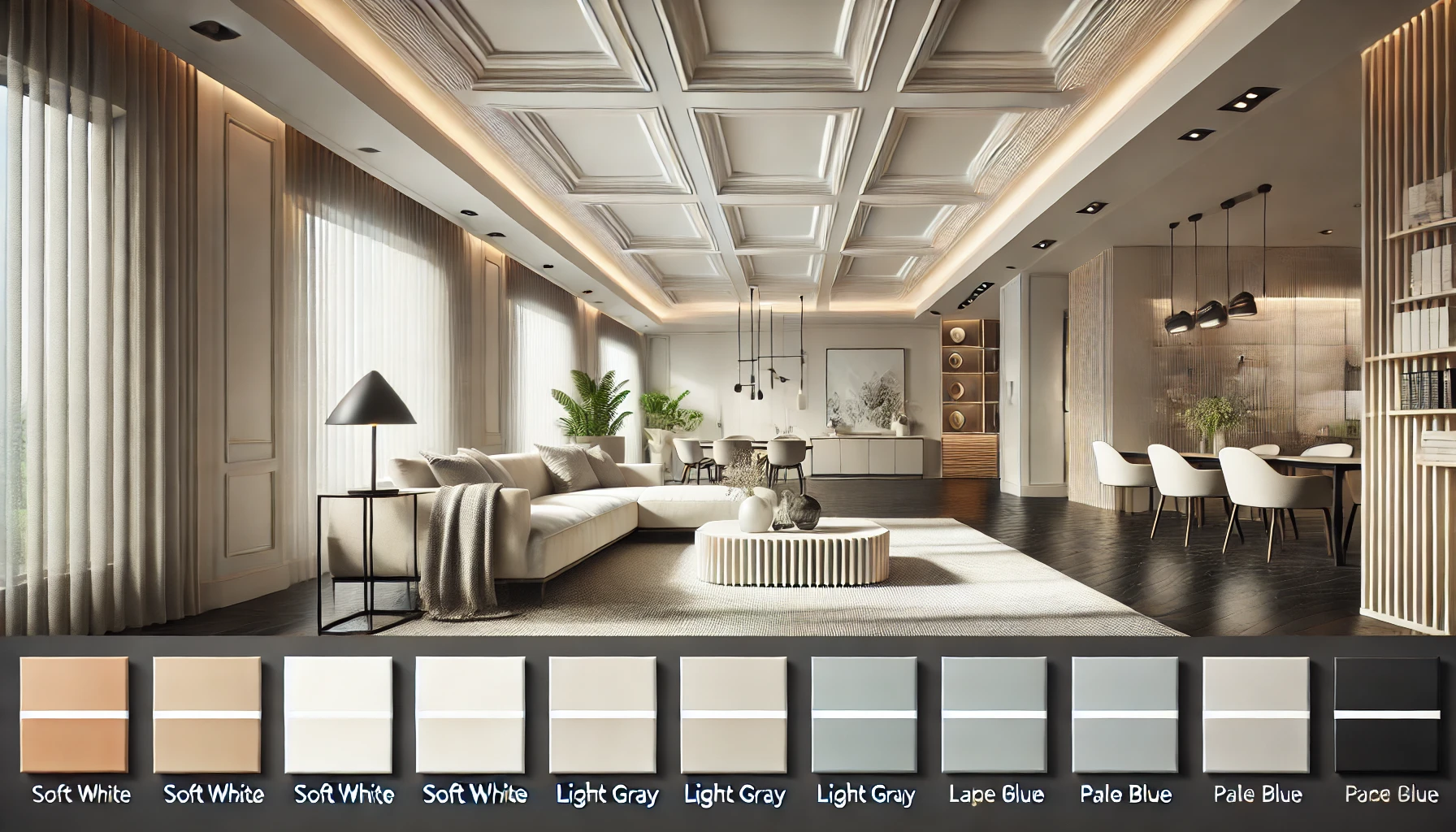
Why Choosing the Right Ceiling Color Matters
Choosing the right color for your basement ceiling is more than a design decision—it’s about creating a space that feels inviting, functional, and tailored to your needs. The color you choose can influence the mood, perception of space, and even the practicality of your basement. Here’s why it’s so important:
The Psychological Impact of Colors
Colors have a powerful impact on emotions and perceptions. For instance:
- White ceilings evoke a sense of cleanliness, brightness, and openness, making the basement feel less enclosed.
- Black ceilings create a cozy, intimate atmosphere, often associated with a modern and stylish aesthetic.
- Gray tones strike a balance, offering neutrality that can feel calming and sophisticated.
Choosing the right color can transform a basement from a functional space to one where you enjoy spending time.
Aesthetic Appeal and Functionality
A carefully chosen ceiling color can enhance both the look and usability of your basement.
- Unifying design elements: A color that complements your walls and flooring creates a cohesive and polished appearance.
- Hiding imperfections: Darker tones like black or deep gray are excellent for concealing ductwork, pipes, and uneven textures in exposed ceilings.
- Highlighting features: Lighter shades can draw attention to decorative elements like beams or lighting fixtures.
Enhancing Space with the Right Choice
Your ceiling color has the power to visually alter the perception of your basement’s dimensions.
- Making small spaces feel larger: Light colors like white or cream can make low ceilings appear higher, creating a sense of spaciousness.
- Adding depth: Darker shades can add visual intrigue to expansive spaces, making them feel more contained and inviting.
- Optimizing lighting: Reflective colors, especially in lighter tones, amplify natural and artificial light, reducing the need for excessive fixtures.
By thoughtfully considering your ceiling color, you can turn your basement into a functional, stylish, and enjoyable part of your home. Let’s move on to explore the factors to consider when making your color choice!
Factors to Consider When Painting Your Basement Ceiling
Choosing the right color for your basement ceiling is more than just a design decision; it’s about practicality, aesthetics, and functionality. Here are key factors to guide your choice:
Purpose of the Basement
When choosing a ceiling color, start by considering the primary use of your basement. For a living area, lighter shades like white or soft gray can create an inviting and spacious feel, while darker tones might suit a storage space, helping to camouflage pipes or beams. A multi-functional basement often benefits from neutral tones that work with diverse activities and designs.
Lighting Conditions
Lighting is a significant factor in how colors appear in your basement. Natural light enhances bright tones, making the space feel open and airy. However, in basements with limited natural light, artificial lighting takes center stage. Warm lighting pairs well with creamy or neutral hues, while cool LED lights complement gray or white shades.
Ceiling Height and Room Size
The dimensions of your basement also influence the choice of ceiling color. If your basement has low ceilings, lighter shades can create an illusion of height, while high ceilings might feel more balanced with darker colors like charcoal or black. Similarly, smaller basements benefit from reflective tones, which can make the room appear larger, while larger basements can carry bolder, darker hues without overwhelming the space.
Coordination with Walls and Floors
A cohesive design is essential for a polished look. Whether you opt for complementary or contrasting colors, ensure that the ceiling color ties in with the walls, flooring, and overall decor. For example, a light gray ceiling can blend seamlessly with neutral walls and concrete floors, while a black ceiling might add a modern, industrial edge to exposed brick or dark wooden flooring.
Popular Color Options for Basement Ceilings
Choosing the right color for your basement ceiling can significantly impact the overall look and feel of the space. Each color brings its own set of benefits and aesthetic appeal, allowing you to tailor the ambiance to your needs and preferences.
White: Bright, Clean, and Expansive
White is a classic choice for basement ceilings, offering a bright and airy feel. It reflects light effectively, making it ideal for basements with limited natural light. White can also create the illusion of higher ceilings, giving the space an open and clean appearance. This color pairs seamlessly with various wall and floor colors, making it a versatile option for any design style.
Black: Bold, Modern, and Concealing
For a sleek and dramatic look, black ceilings are an excellent choice. They add a modern, industrial vibe to the basement while effectively concealing imperfections, pipes, or ductwork. Black absorbs light, creating a cozy atmosphere, which works particularly well in home theaters or entertainment areas. However, it’s best suited for basements with ample lighting to prevent the space from feeling too dark.
Gray: Neutral, Versatile, and Stylish
Gray strikes a perfect balance between white and black, offering a neutral yet sophisticated option. Light gray tones can brighten the space while maintaining a sense of coziness, while darker grays provide depth and warmth. Gray ceilings are also highly versatile, blending beautifully with various wall and flooring styles, from rustic to contemporary.
Other Unique Options (Blue, Beige, etc.)
For those looking to add personality to their basement, unique colors like blue, beige, or even green can create a distinct ambiance. Light blue ceilings evoke a calming effect, reminiscent of the sky, making the space feel serene and expansive. Beige adds warmth and softness, complementing neutral or earthy tones in the decor. These unique options can personalize your basement while maintaining a stylish and cohesive look.
By carefully selecting the right color for your basement ceiling, you can enhance the functionality and aesthetics of the space, ensuring it aligns perfectly with your vision and needs.
Best Paint for Basement Ceilings
Selecting the best paint for your basement ceiling is crucial for achieving a lasting and appealing finish. From the type of paint to its finish and brand, every choice impacts the outcome. Here’s a breakdown to guide you:
Types of Paints for Different Ceiling Types
The type of ceiling you have will determine the most suitable paint:
- Exposed Ceilings: For ceilings with exposed pipes, beams, or ductwork, latex-based paint is an excellent choice due to its durability and ease of application. It adheres well to various surfaces like wood and metal.
- Drywall Ceilings: Acrylic paint is ideal for drywall, offering smooth coverage and resistance to moisture, which is important in basements prone to dampness.
- Textured Ceilings: For textured or popcorn ceilings, a thicker paint or spray-applied option can provide even coverage without losing the texture.
Paint Finishes: Matte, Semi-Gloss, or Gloss
The finish you choose affects the ceiling’s appearance and maintenance:
- Matte Finish: Provides a smooth, non-reflective surface that hides imperfections but may be harder to clean. Best for areas with minimal activity.
- Semi-Gloss Finish: Offers a slight sheen that reflects light, brightening the space and making it easier to clean. It’s a popular choice for exposed ceilings.
- Gloss Finish: Highly reflective and easy to clean, but it can highlight flaws. It works well in basements where high moisture resistance is needed.
Recommended Brands for Durability
Opting for high-quality paint ensures better coverage and longevity. Here are some trusted brands:
- Behr Premium Plus: Known for its excellent coverage and stain-blocking properties, ideal for basement environments.
- Sherwin-Williams Duration Home: Durable and moisture-resistant, making it suitable for high-humidity areas like basements.
- Benjamin Moore Regal Select: Offers a range of finishes and superior adhesion for various ceiling types.
- Rust-Oleum Protective Enamel: Perfect for exposed metal surfaces, providing rust prevention and a smooth finish.
Choosing the right paint type, finish, and brand will not only enhance the aesthetics of your basement ceiling but also ensure its durability against the unique challenges basements often face, such as humidity and limited lighting.
Step-by-Step Guide to Painting Your Basement Ceiling
Painting your basement ceiling can be a great way to improve the overall look of the space while making it feel brighter and more inviting. Follow this detailed guide to achieve professional-looking results.
Preparing the Basement for Painting
- Clear the Area: Remove furniture and cover the floor with a drop cloth or plastic sheeting to protect it from paint splatters.
- Clean the Ceiling: Dust and clean the ceiling to ensure the paint adheres properly. Use a vacuum with a soft brush attachment or a damp cloth.
- Fix Any Imperfections: Repair any holes or cracks with spackle or caulk. Sand smooth once dry.
- Mask Off the Walls: Use painter’s tape to protect the walls from accidental drips or brush strokes.
Choosing the Right Tools and Equipment
- Paint Type: Select the appropriate paint for your basement ceiling. Opt for a mildew-resistant, high-quality ceiling paint in a flat or matte finish.
- Brushes and Rollers: For a smooth finish, use a high-quality roller with a thick nap for textured surfaces. Smaller brushes will help you reach corners and edges.
- Extension Pole: A long extension pole will help you reach higher areas, avoiding the need for ladders or scaffolding.
- Drop Cloths and Tape: Protect the floor and walls with drop cloths, and use painter’s tape for clean lines.
Techniques for Painting an Exposed Ceiling
- Start with Primer: If your ceiling is raw or exposed, apply a coat of primer to ensure proper paint adhesion.
- Work in Sections: Start from one corner of the room and work in small sections, ensuring each part is fully covered before moving on.
- Use a Roller for Large Areas: For a smooth finish on large ceiling surfaces, use a roller. Work in a “W” pattern to ensure even coverage.
- Use a Brush for Edges and Tight Spots: Use a brush to carefully paint along the edges, corners, and areas where the ceiling meets the walls.
Safety Tips for a Hassle-Free Experience
- Wear Protective Gear: Always wear safety glasses, a respirator or dust mask, and gloves to protect yourself from fumes and paint splatters.
- Ensure Proper Ventilation: Open windows or use fans to improve air circulation and reduce the buildup of fumes.
- Take Regular Breaks: Working overhead can be taxing on your arms and back. Take breaks to avoid fatigue and ensure you maintain focus.
- Use Ladders Safely: If you need to use a ladder, ensure it is sturdy and positioned correctly to avoid accidents.
Pros and Cons of Painting Basement Ceilings
Painting your basement ceiling can be a great way to improve the space, but it comes with both benefits and challenges. Let’s take a look at the pros and cons of painting your basement ceiling.
Advantages (Aesthetics, Accessibility, Budget-Friendly)
One of the main advantages of painting your basement ceiling is the aesthetic improvement. A fresh coat of paint can brighten up the space, making it feel more welcoming and less dark or gloomy. It can also help to cover up any old pipes, wires, or other unsightly elements in the ceiling, giving your basement a cleaner, more finished look.
Another benefit is accessibility. Painting a basement ceiling is a task that most homeowners can do themselves without needing to hire a professional. With the right tools and some preparation, you can achieve great results on your own.
In addition, painting your basement ceiling is a budget-friendly option compared to other renovation projects. It requires fewer materials and can be done for a relatively low cost, especially if you already have the necessary tools.
Drawbacks (Time Investment, Maintenance, Pest Control)
On the downside, painting your basement ceiling can be time-consuming. It often takes several hours to properly prep the space, apply the paint, and allow it to dry between coats. This may not be ideal if you’re looking for a quick improvement.
Another drawback is the maintenance required. Basement ceilings, especially if they are exposed to moisture or humidity, may need more frequent touch-ups. Over time, the paint may peel or discolor, requiring extra effort to keep it looking fresh.
Lastly, painted ceilings can sometimes hide potential issues like pests or leaks. If you paint over pipes or wires, you might not notice problems that need attention. Regular inspections are necessary to make sure that hidden issues don’t go unnoticed.
Special Focus: Exposed Basement Ceilings
Exposed basement ceilings are becoming a popular design choice, offering a modern and industrial look. While they come with their own set of benefits, painting them requires careful consideration. Here’s a closer look at why exposed ceilings are trending, the best colors for them, and the challenges involved in painting them.
Why Exposed Ceilings Are Trending
Exposed ceilings are gaining popularity because they create a stylish, open feel, especially in basements where low ceilings can make a space feel cramped. The industrial look, with visible beams, pipes, and ducts, adds character and a sense of authenticity to the room. Many homeowners love the raw, unfinished aesthetic, which can give a basement a trendy, loft-like appearance. This style is especially appealing for those who enjoy modern, minimalist, or industrial interior design.
Ideal Colors for Exposed Ceilings
When it comes to choosing colors for an exposed basement ceiling, darker shades like black or charcoal grey are popular choices, as they make the ceiling blend into the background and create a more expansive feel. Lighter colors, such as white or soft greys, can brighten the space and make the room feel larger, especially in basements with low ceilings. If you want to keep the industrial vibe, metallic finishes or matte black can complement the raw look of exposed beams and pipes. Choose a color that fits the overall aesthetic of your basement and enhances the design.
Challenges of Painting Exposed Ceilings
Painting exposed ceilings can be tricky because of the uneven surfaces and the need to work around pipes, beams, and other structural elements. The process can be time-consuming, especially if the ceiling is high or has intricate features. In addition, exposed ceilings are more susceptible to showing dust, cobwebs, and other marks, so regular cleaning and touch-ups are essential. Lastly, reaching all areas of the ceiling can be physically demanding, requiring special tools like extension poles or scaffolding.
If you’re looking for more ways to enhance your basement, you might be interested in learning about basement playroom ideas for kids or how to properly waterproof your basement with our complete guide on waterproofing.
Inspiration: Real-Life Examples of Painted Basement Ceilings
Seeing how painted basement ceilings can transform a space is often the best inspiration. Real-life examples show the dramatic difference a fresh coat of paint can make, from dark and dingy to bright and inviting. Let’s explore some before-and-after transformations and creative ways people are using colors and textures on their basement ceilings.
Before and After Transformations
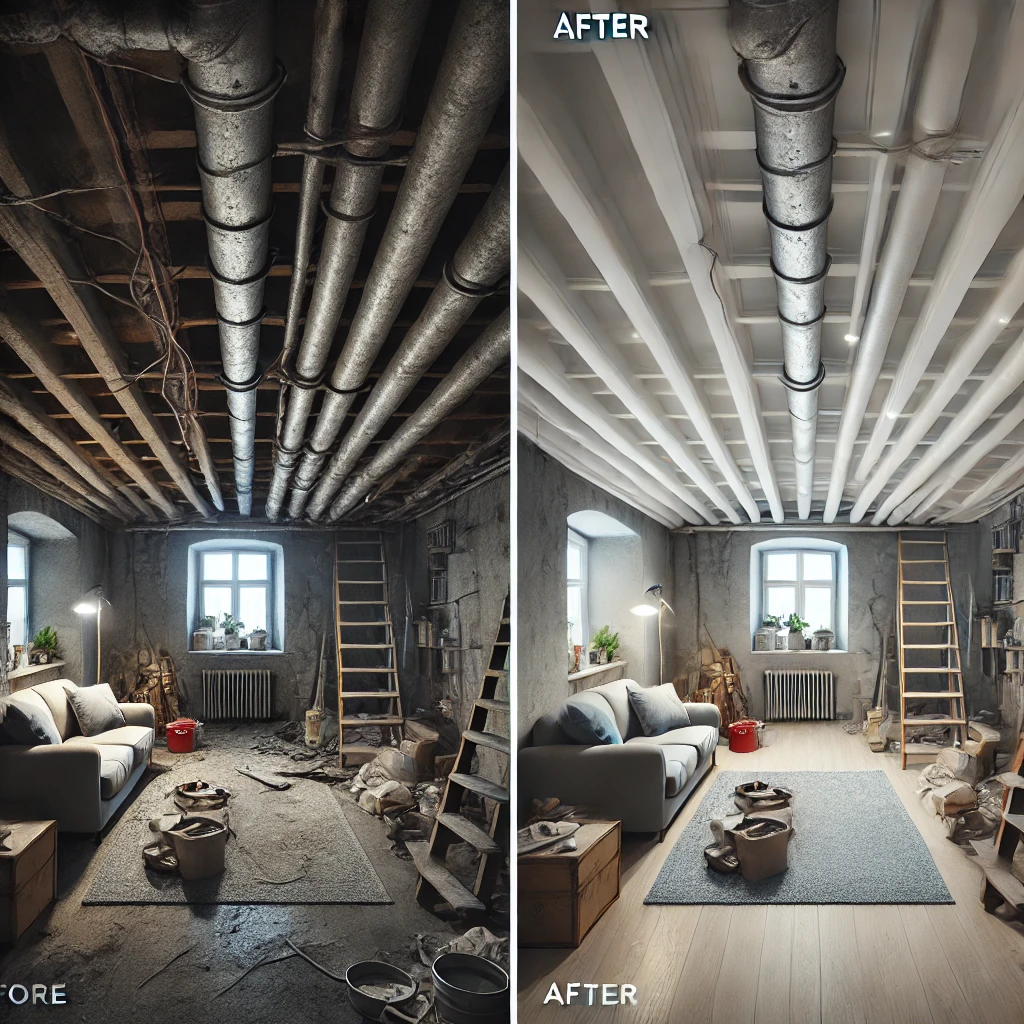
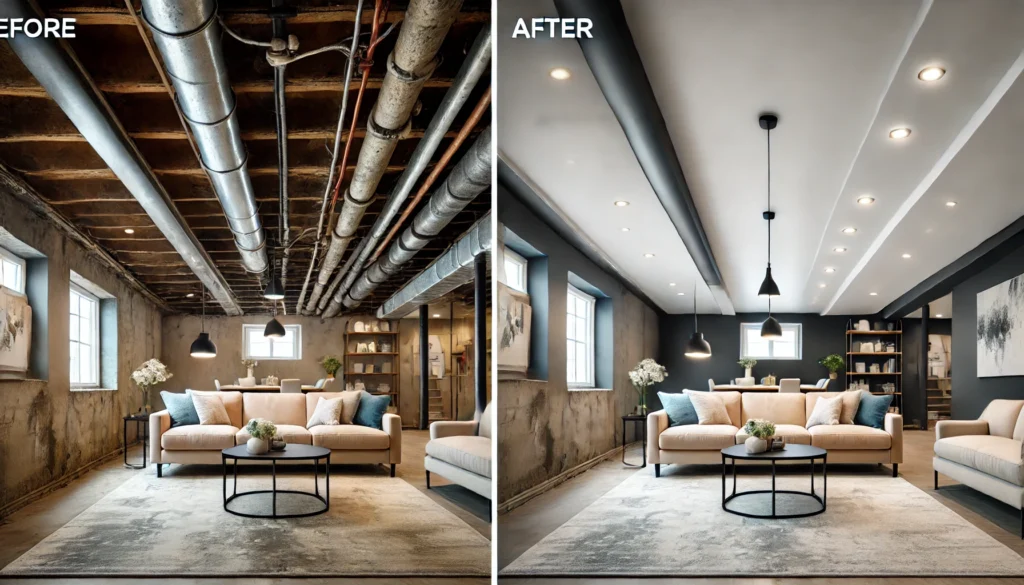
Creative Uses of Colors and Textures
Many people are getting creative with their basement ceiling paint choices. Instead of just using a flat color, some homeowners incorporate textured finishes like metallics, faux wood, or chalkboard paint. Metallic finishes such as silver or gold can add a touch of elegance and sophistication, especially when paired with sleek furniture.
When to Call a Professional
While painting your basement ceiling can be a DIY project, there are times when it’s best to bring in a professional. Knowing when to call an expert can save you time, effort, and potentially costly mistakes.
Signs You Need Expert Help
If your basement ceiling has high, hard-to-reach areas or complex features like intricate beams and pipes, it may be time to call a professional. Also, if you’re dealing with significant damage, such as water stains, mold, or cracks that need repairing, an expert can ensure the job is done right. If you’re not comfortable working on ladders or using specialized equipment, hiring a professional painter will also help you avoid safety risks. A professional can handle these challenges, ensuring your ceiling is painted beautifully and securely.
How to Choose a Reliable Painting Contractor
Choosing the right contractor is essential for a successful painting project. Look for contractors who have experience working in basements and handling the unique challenges they present. Ask for references and review their past work to ensure their style and quality meet your standards. Additionally, make sure the contractor is licensed and insured, so you’re covered if anything goes wrong during the job. Get multiple quotes to compare prices and ensure you’re getting fair value for the work.
Tips to Maintain Your Painted Basement Ceiling
Once your basement ceiling is painted, it’s important to keep it looking fresh and in good condition. Regular maintenance will help your ceiling last longer and maintain its appearance.
Cleaning and Touch-Up Tips
To keep your painted basement ceiling looking its best, clean it regularly to remove dust and cobwebs. Use a soft broom or vacuum with a brush attachment to gently clean the surface. For minor stains, spot clean with a damp cloth. If you notice any chips or scratches, use touch-up paint to fix them right away. This will help maintain a smooth, uniform appearance over time.
Addressing Wear and Tear
Over time, your painted ceiling may show signs of wear and tear, especially in a basement where humidity levels can fluctuate. If you notice peeling, discoloration, or damage from leaks, take action quickly to prevent further damage. Address any underlying issues, such as moisture problems, before repainting. Regularly inspect your ceiling for any signs of mold, mildew, or water damage and fix them promptly to keep your basement ceiling looking as good as new.
To avoid damp conditions that could affect paint, check out our tips on how to get rid of musty smells in your basement.
Conclusion
Painting your basement ceiling can offer a multitude of benefits, from transforming a dark, cramped space into a bright, airy room to improving the overall aesthetic of your home. Whether you choose to enhance the industrial charm with dark tones or open up the space with lighter shades, a painted ceiling can completely change the feel of your basement. It’s a cost-effective way to update the look of your space, and with the right tools and techniques, it’s something you can easily tackle yourself—or with the help of a professional if needed.
So, don’t wait any longer—take action and give your basement the makeover it deserves! A freshly painted ceiling is a simple yet impactful way to elevate your home and create a welcoming, stylish area for family activities, entertainment, or relaxation.


